Computer English Unit 3 Computer Language and Programming(计算机英语 第三单元 计算机语言与编程)
- 格式:doc
- 大小:63.50 KB
- 文档页数:10
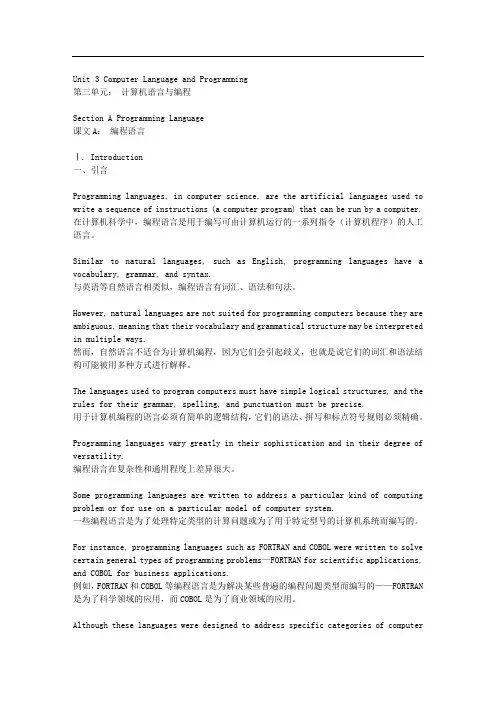
Unit 3 Computer Language and Programming第三单元:计算机语言与编程Section A Programming Language课文A:编程语言Ⅰ. Introduction一、引言Programming languages, in computer science, are the artificial languages used to write a sequence of instructions (a computer program) that can be run by a computer. 在计算机科学中,编程语言是用于编写可由计算机运行的一系列指令(计算机程序)的人工语言。
Similar to natural languages, such as English, programming languages have a vocabulary, grammar, and syntax.与英语等自然语言相类似,编程语言有词汇、语法和句法。
However, natural languages are not suited for programming computers because they are ambiguous, meaning that their vocabulary and grammatical structure may be interpreted in multiple ways.然而,自然语言不适合为计算机编程,因为它们会引起歧义,也就是说它们的词汇和语法结构可能被用多种方式进行解释。
The languages used to program computers must have simple logical structures, and the rules for their grammar, spelling, and punctuation must be precise.用于计算机编程的语言必须有简单的逻辑结构,它们的语法、拼写和标点符号规则必须精确。

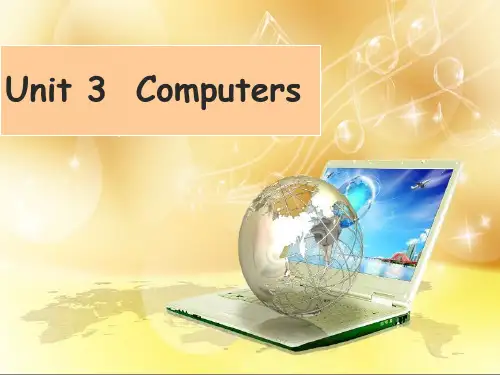
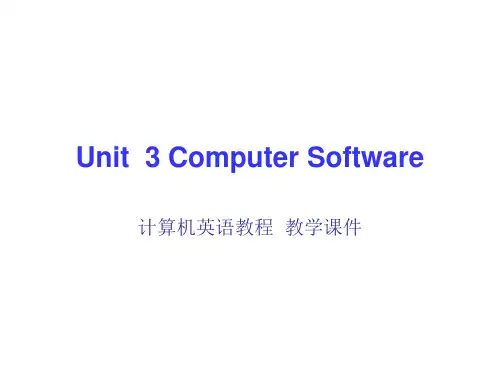
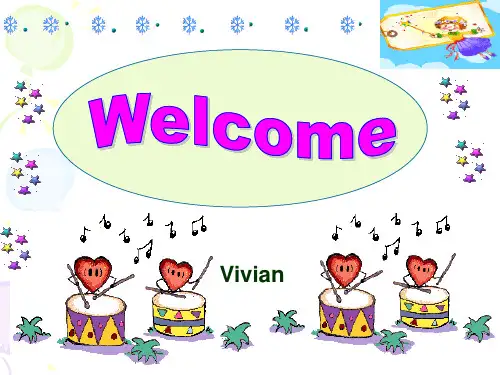
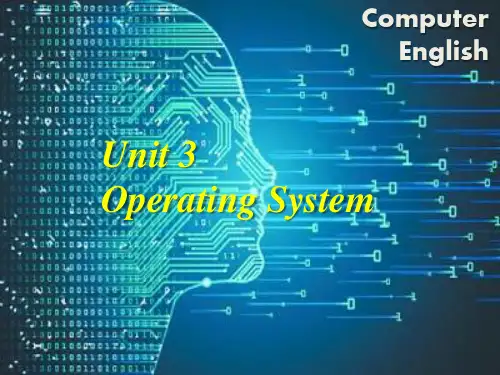
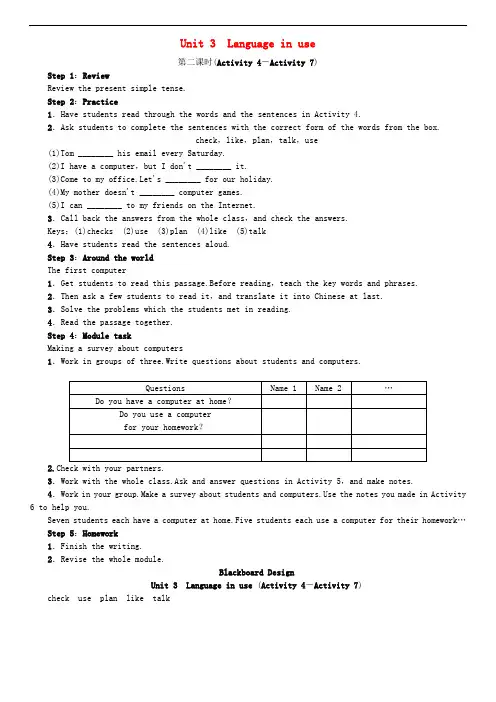
Unit 3 Language in use第二课时(Activity 4-Activity 7)Step 1:ReviewReview the present simple tense.Step 2:Practice1.Have students read through the words and the sentences in Activity 4.2.Ask students to complete the sentences with the correct form of the words from the box.check,like,plan,talk,use(1)Tom ________ his email every Saturday.(2)I have a computer,but I don't ________ it.(3)Come to my office.Let's ________ for our holiday.(4)My mother doesn't ________ computer games.(5)I can ________ to my friends on the Internet.3.Call back the answers from the whole class,and check the answers.Keys:(1)checks (2)use (3)plan (4)like (5)talk4.Have students read the sentences aloud.Step 3:Around the worldThe first computer1.Get students to read this passage.Before reading,teach the key words and phrases.2.Then ask a few students to read it,and translate it into Chinese at last.3.Solve the problems which the students met in reading.4.Read the passage together.Step 4:Module taskMaking a survey about computers1.Work in groups of three.Write questions about students and computers.2.3.Work with the whole class.Ask and answer questions in Activity 5,and make notes.4.Work in your group.Make a survey about students and e the notes you made in Activity 6 to help you.Seven students each have a computer at home.Five students each use a computer for the ir homework…Step 5:Homework1.Finish the writing.2.Revise the whole module.Blackboard DesignUnit 3Language in use (Activity 4-Activity 7)check use plan like talk。
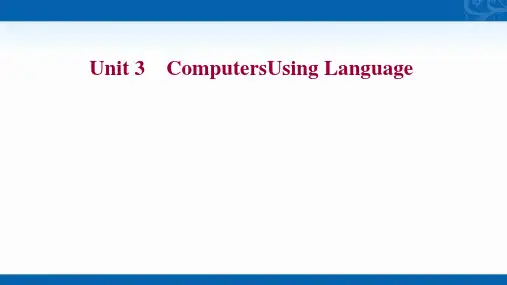
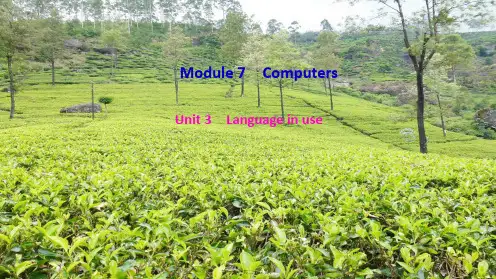
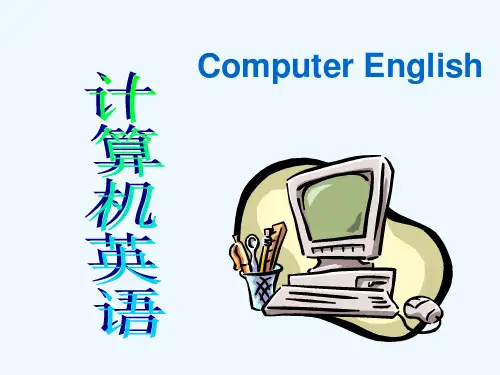
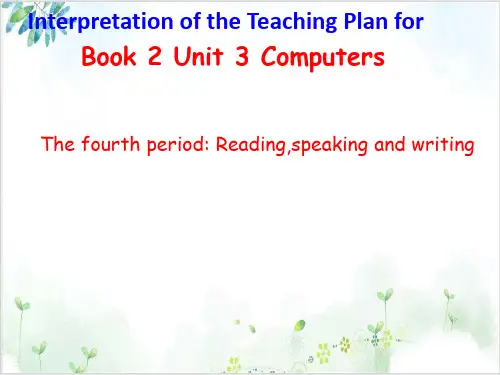
感顿市安乐阳光实验学校Period ⅢLanguage PointsⅠ.语境填词1.A____________,I will never give up.2.The flowers look true,but they are a________ in fact.3.High science and t__________ leads to fast development of economy.4.Many new a__________ have been found for computers since the 1970s.5.Our team won the game by two g________ to one.6.This dictionary tries to ________(简化)the meanings of words.7.The employees must pass an ________(智力)test before being hired by the boss.8.You’d better hand your paper to him __________(亲自).9.A ________(完全地) blind man can see nothing.10.One day,I’ll ________(探测) the surface of the moon.Ⅱ.完成句子1.时间一年年过去,老人越来越孤独。
As the years __________,the old man became ____________ lonely.2.司机的粗心驾驶导致了这次车祸。
The driver’s carelessness __________ the accident.3.在老师的帮助下,他的英语学习取得了很大的进步。
______________ his teacher,he made great progress in his English study.4.从现在起你可以工作了。
Unit 3 Computer Language and Programming第三单元:计算机语言与编程Section A Programming Language课文A:编程语言Ⅰ. Introduction一、引言Programming languages, in computer science, are the artificial languages used to write a sequence of instructions (a computer program) that can be run by a computer. 在计算机科学中,编程语言是用于编写可由计算机运行的一系列指令(计算机程序)的人工语言。
Similar to natural languages, such as English, programming languages have a vocabulary, grammar, and syntax.与英语等自然语言相类似,编程语言有词汇、语法和句法。
However, natural languages are not suited for programming computers because they are ambiguous, meaning that their vocabulary and grammatical structure may be interpreted in multiple ways.然而,自然语言不适合为计算机编程,因为它们会引起歧义,也就是说它们的词汇和语法结构可能被用多种方式进行解释。
The languages used to program computers must have simple logical structures, and the rules for their grammar, spelling, and punctuation must be precise.用于计算机编程的语言必须有简单的逻辑结构,它们的语法、拼写和标点符号规则必须精确。
Programming languages vary greatly in their sophistication and in their degree of versatility.编程语言在复杂性和通用程度上差异很大。
Some programming languages are written to address a particular kind of computing problem or for use on a particular model of computer system.一些编程语言是为了处理特定类型的计算问题或为了用于特定型号的计算机系统而编写的。
For instance, programming languages such as FORTRAN and COBOL were written to solve certain general types of programming problems—FORTRAN for scientific applications, and COBOL for business applications.例如,FORTRAN和COBOL等编程语言是为解决某些普遍的编程问题类型而编写的——FORTRAN 是为了科学领域的应用,而COBOL是为了商业领域的应用。
Although these languages were designed to address specific categories of computerproblems, they are highly portable, meaning that they may be used to program many types of computers.尽管这些语言旨在处理特定类型的计算机问题,但它们具有很高的可移植性,也就是说它们可以用来为多种类型的计算机编程。
Other languages, such as machine languages, are designed to be used by one specific model of computer system, or even by one specific computer in certain research applications.其他的语言,如机器语言,是为一种特定型号的计算机系统,甚至是一台特定的计算机,在某些研究领域使用而编写的。
The most commonly used programming languages are highly portable and can be used to effectively solve diverse types of computing problems.最常用的编程语言具有很高的可移植性,可以用于有效地解决不同类型的计算问题。
Languages like C, PASCAL, and BASIC fall into this category.像C、PASCAL和BASIC这样的语言就属于这一范畴。
Ⅱ. Language Types二、语言类型Programming languages can be classified as either low-level languages or high-level languages.编程语言可分为低级语言和高级语言。
Low-level programming languages, or machine languages, are the most basic type of programming languages and can be understood directly by a computer.低级编程语言或机器语言,是编程语言中最基础的类型,可以被计算机直接理解。
Machine languages differ depending on the manufacturer and model of computer.机器语言视计算机制造商与型号不同而有所区别。
High-level languages are programming languages that must first be translated into a machine language before they can be understood and processed by a computer.高级语言是必须首先翻译成机器语言计算机才能理解和处理的编程语言。
Examples of high-level languages are C, C++, PASCAL, and FORTRAN.C、C++、PASCAL和FORTRAN都是高级语言的例子。
Assembly languages are intermediate languages that are very close to machine languages and do not have the level of linguistic sophistication exhibited by other high-level languages, but must still be translated into machine language.汇编语言是中级语言,非常接近于机器语言,没有其他高级语言所表现出的语言复杂程度,但仍然得翻译成机器语言。
1. Machine Languages1、机器语言In machine languages, instructions are written as sequences of 1s and 0s, called bits, that a computer can understand directly.在机器语言中,指令被写成计算机能够直接理解的1和0(称作位)序列。
An instruction in machine language generally tells the computer four things:一条机器语言指令一般告诉计算机4件事:(1) where to find one or two numbers or simple pieces of data in the main computer memory (Random Access Memory, or RAM),(1)到计算机主存(随机存储器)的什么位置去找一两个数字或简单的数据片;(2) a simple operation to perform, such as adding the two numbers together, (2)要执行的简单操作,如将两个数字相加;(3) where in the main memory to put the result of this simple operation, and (3)在主存的什么位置存放该简单操作的结果;(4) where to find the next instruction to perform.(4)到什么位置去找下一条要执行的指令。
While all executable programs are eventually read by the computer in machine language, they are not all programmed in machine language.尽管所有的可执行程序最终都是以机器语言的形式被计算机读入的,但它们并非都是用机器语言编写的。
It is extremely difficult to program directly in machine language because the instructions are sequences of 1s and 0s.直接用机器语言编程极端困难,因为指令是0和1的序列。
A typical instruction in a machine language might read 10010 1100 1011 and mean add the contents of storage register A to the contents of storage register B.一条典型的机器语言指令可能写成100101100 1011,意思是把存储寄存器A的内容加到存储寄存器B的内容中。